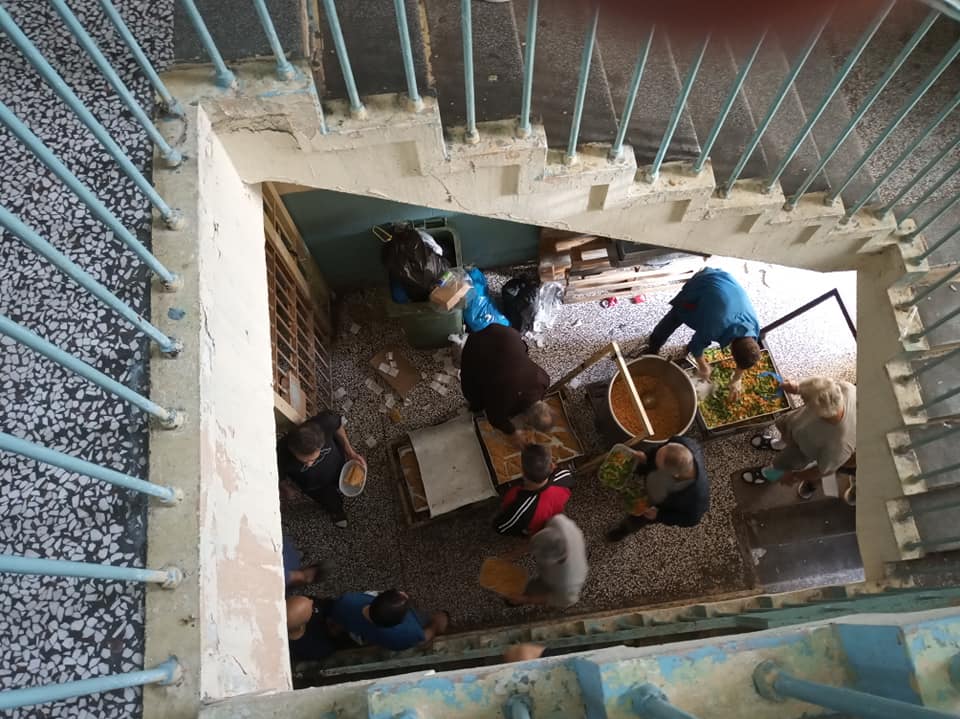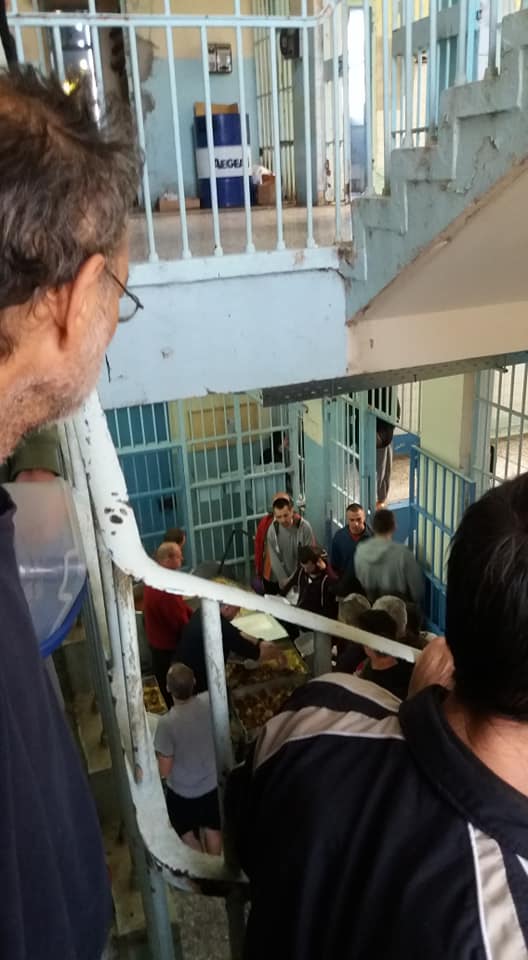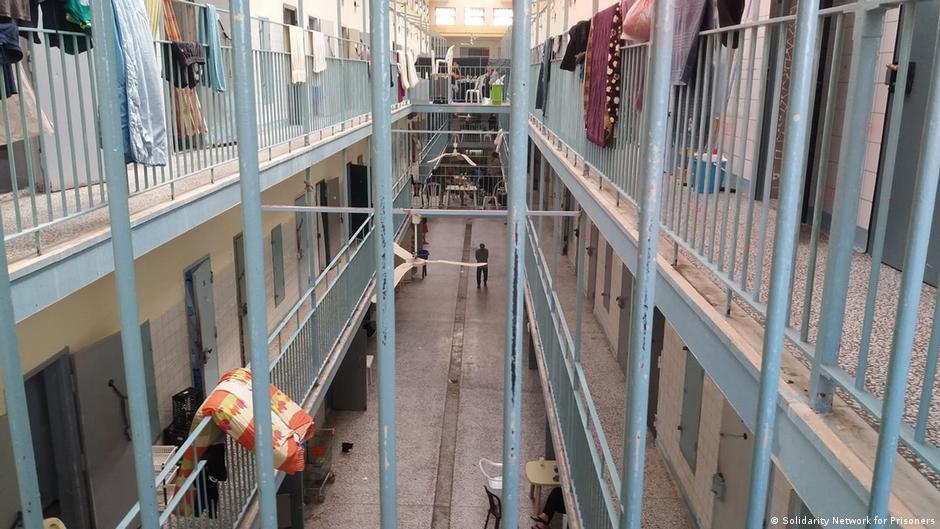MIIR - iMEdD investigation: Covid-19 spread twice as fast in Greek prisons
Overcrowding, abuse of the minimum personal space of prisoners, hospitalization without segregation of patients, crowded quarantine, lack of medical staff and health measures, delayed vaccination.
These are just some of the causes that lead to the virus’s spread.
March 12, 2022
Research – Text: Nikos Morfonios, Ioanna Louloudi (MIIR)
Reseach and data visualisation: Thanasis Troboukis (iMΕdDLab)*
“When I got COVID in December 2020, around half of the prisoners in the Larissa Prison were sick at the same time. We were put into a ward with 60 people, in a space of around 110 square meters. It was a roll of the dice whether you were going to be severely or just mildly ill.” The testimony of Vangelis Stathopoulos, a prisoner of the Larissa Prison, vividly summarizes the situation of Covid-19 in Greek prisons. It is confirmed by the findings of a large analysis of data from 32 countries, conducted by 12 European media outlets led by Deutsche Welle within the European Data Journalism Network (EDJNet).
The MIIR (Mediterranean Institute for Investigative Reporting) and iMΕdD (Incubator for Media Education and Development) collected and processed the specific data concerning Greek prisons. This concerned their capacity, overcrowding, covid cases, deaths, access to healthcare and vaccination. In parallel, interviews were conducted with prisoners, specialists and scientists. Other institutional factors were also taken into account in the context of this pan-European research. What were the conclusions about Greek prisons?
The virus spread twice as fast in prisons compared to the rest of society. As a result, one third of prisoners have been sick to date. Explanations include cells with prisoners crowded into a few square meters; makeshift wards without any separation of patients; crowded quarantine areas filled with both healthy people and suspected cases; and insufficient access to healthcare and safety measures. Moreover, prisoners’ rights have been curtailed with the cancellation of visits and activities.
For the data on covid cases, deaths and vaccinations until February 2022, the sources are the General Secretariat for Crime Policy, Greece’s “Special Standing Committee on the Penitentiary System and Other Structures concerning the Detention of Prisoners”, and the “Report on the Coronavirus by the General Secretariat of Anti-Crime Policy” submitted to the Greek Parliament on 12 November 2020 by the Deputy Minister of Civil Protection, Lefteris Oikonomou.
In Greece, the overcrowded prisons have created a favorable ground for the reproduction and spread of the coronavirus. It is not just the fact that based on the comparative data of the research, Greece appears in 7th place (as of January 2020) in the list of the most crowded prisons in Europe – this refers to the official number of prisoners each prison can hold and the actual population living within the walls. It is mainly the investigation’s finding in relation to the minimum living space of each detainee based on international conventions – in 25 of the 34 Greek prisons, this requirement is disrespected, making prisoners even more exposed to the virus.
For the same reason, our comparative analysis of the data reveals a shocking reality: Greece is one of the European countries that had the highest spread of the virus in prisons compared to the spread in the general population. By 2 July 2021, 16 months after the start of the pandemic, it is estimated that 7.9% of the prisoners in total were infected with the virus. The figure for the general population was 4.1%. Transmission inside prisons was almost twice as high as outside the prisons. The situation was similar in Northern Ireland, Italy, England and Wales, Slovenia, Belgium and Catalonia. In contrast, there was a smaller spread of the disease within prisons (compared to the general population) in Hungary, Austria, Spain (excluding Catalonia), Ireland, Switzerland, Albania, Germany and Scotland.
Regarding the number of cases, Ioannina and Patras reported more than 300 cases per 1,000 inmates in prisons (392 and 339 respectively) between 1 March and 1 July 2021. They were followed by Larissa (278) and the special health center for prisoners at Korydallos (272) – though it is estimated that cases that have been reported there had been transferred from other wards or from other prisons. In the first three prisons it is estimated that the occupancy rate during the pandemic was kept constantly above 100%. In Ioannina the number of inmates was almost double the actual available capacity. In Patras the proportion reached 137% and in Larissa 129%.
We collected new data in November 2021, finding again that the transmission in Greek prisons was more than double compared to the rest of society (16.8% vs. 7.2%). By February 2022, a period covered by the 4th wave of the pandemic and the outbreak of Omicron, 32.6% of prisoners had been diagnosed with coronavirus compared with 21.2% of the general population. In absolute numbers, the data in the Greek penitentiary establishments from the beginning of the pandemic until February 2022 reported 3,541 cases and 14 deaths. Disease management within prisons has been improvised and fragmented in response to the pandemic, and this has been added to the traditional structural problems of Greek penitentiaries.
Korydallos prison – Credit: Prisoners’ Solidarity Network
Less than 4 square meters of personal space in 25 of the 34 prisons
The minimal space of 4 square meters is important, not only in times of pandemic. Everyone, even in prison, has a right to a minimum of privacy.
“In Larissa prisons, the cells are for 8 and 10 people, so if someone gets sick, it makes sense that in a very small space of 15 square meters everyone will probably get sick,” says Stathopoulos, describing the suffocating situation in the cells.
According to the data, until 1 July 2021 in 25 of the 34 prisons of the country, each prisoner disposed of 4 square meters. The European Committee for the Prevention of Torture (CPT) of the Council of Europe has defined this space as the minimum per detainee in his cell. More specifically, in the special detention center for young people in Volos, each detainee had approximately 1.9 square meters of personal space. In Tripoli it was 2.1, in Kos and Komotini 2.3, in Ioannina 2.4, and in Chalkida and Nafplio 2.7 square meters.
“Every prisoner, according to the European Committee’s proposal for the Prevention of Torture and Inhuman or Degrading Treatment or Punishment (CPT), should have at least four square meters of living space in his chamber and six square meters in his cell”, explains Giannis Petsas, who holds a PhD in penitentiary policy. According to the CPT’s protocol, each cell should be at least 6 square meters if it accommodates one detainee, while for each additional detainee the area of the cell should be expanded by 4 square meters. “This area is important”, points out Mr Petsas: “Not only for periods of pandemic. It is already very small and does not protect against the spread of the virus. But also in general, because every person even inside a prison must have a minimum of privacy so that he can live as best as he can. When you do not have this space and you are visible to others at all times, then basic human rights are violated.”
The reality is that the living space of each inmate in a prison is even less than the result of our data analysis. This used the median number of inmates per month in relation to the total area of each prison. The exact number of cells is not known even by the General Secretariat for Anti-Crime Policy. When we asked exactly how many cells there are in the country’s prisons, what their size is and how many prisoners live in them, the GAP’s answer was that “we take the total space per detention center and divide it by 16 sq m. which should be each cell (4 prisoners), since each prisoner should have 4 square meters (based on CPT specifications). We would like to inform you that in the SPACEI questionnaire (this is the annual report with statistics on prisons of the Council of Europe) on 31 January 2020, Greece reported – as a total number of cells (in the country) – 2,747. We commented that the number of cells was calculated based on the minimum standards of the CPT for the space per inmate 4 square meters”. In other words, the 2,747 cells do not correspond to real data, but to the ideal and imaginary scenario that every prisoner should have a living space of 4 square meters.
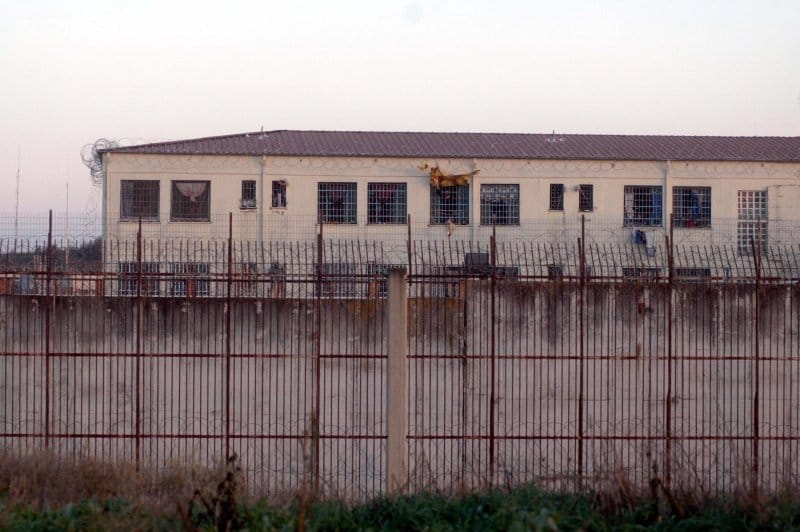
Larisa prison. Credit: Prisoners Solidarity Network
Overcrowding makes prisons health hazards
In the comparative data from 32 countries collected during the research, Greece appears in 7th place overall for overcrowded conditions in Europe. Based on the more specific data on the occupancy rate in Greek prisons, it appears that the average occupancy rate – based on the comparative analysis of the actual prison population and space in each institution, during the period from 1/1/2020 to 1/1/2022 – far exceeds 100% in 25 of the 34 institutions.
“There are several countries where there are more people in prisons than there should be,” said Filipa Alves da Costa, a public health expert at the World Health Organization’s Prison Health Program. “So there is the issue of overcrowding, and even in areas where there is no overcrowding, the occupancy is always close to 100%. This means that prisoners cannot follow the rules of physical distancing, for example. Therefore there is a greater risk when the virus is introduced into the prison environment, precisely because it is a closed living structure and it is not possible to comply with the conditions of distancing. In other words, it is a reinforcing factor of the effects of the virus compared to what we encounter in the rest of society”, she notes.
In the case of Greece it seems from the data analysis that during the pandemic the occupancy of Greek prisons not only did not decrease, but on the contrary increased! Specifically, while on 1 January 2020 (before the pandemic) the occupancy was 107%, from April 2020 to May 2021 it increased to 113.1% (July 2021).
In fact, according to the data, on 1/1/2022 in the special prison for young people in Volos, the occupancy reaches 201.9%. In Komotini it was 188.3%, in Tripoli 181.1%, in Corfu 173.9%, in Ioannina 154.5%, followed by the prisons of Chalkida (154.3%), Patras (148.9%), Nafplio (147.6%) and Kos (144.6%).
But there is another variable that makes prisoners vulnerable to the coronavirus. “Many detainees have many factors that put them at increased risk for a serious Covid-19 case, including conditions such as HIV and a history of smoking or other drugs. Marginalization, poverty and inadequate access to health care often burden these populations even before imprisonment, and prison conditions often exacerbate these factors,” according to the WHO. “In prison we consider people in their 50s to be older, even though they would not be if they were part of a community,” said Da Costa.
The WHO special advisor’s description corresponds to the case of Greek prisons. Poor living conditions, inadequate access to healthcare, a lack of support for medical staff and a lack of effective healthcare measures by prison administrations and the General Secretariat for Crime Policy – all exacerbate the transmission problem.
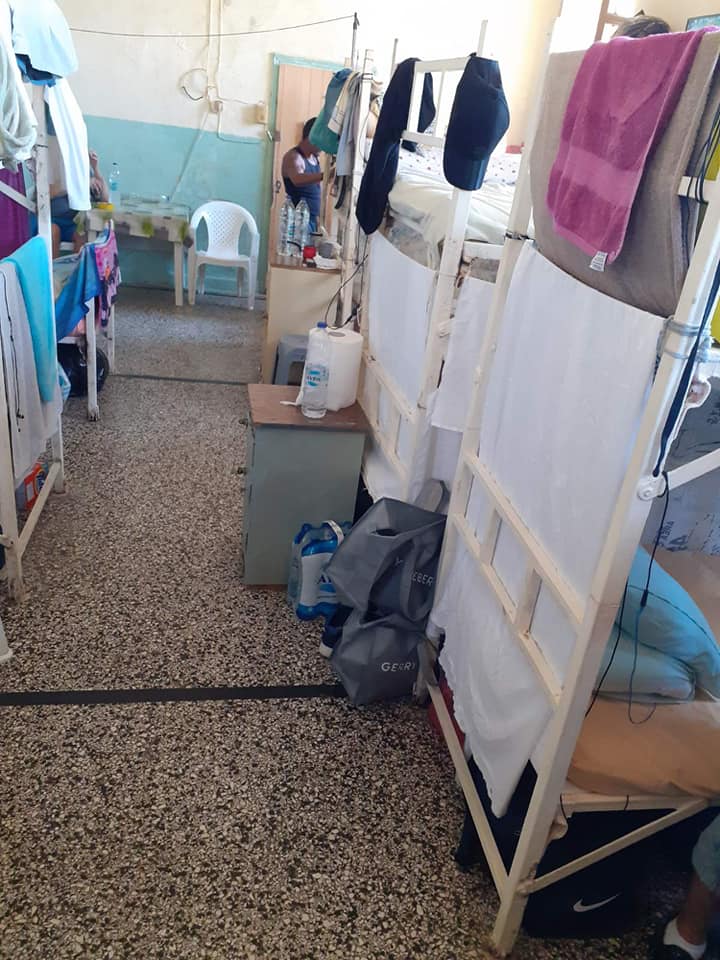
Chalkida prison. Credit: Prisoners’ Solidarity Network
Inmates play doctor
Vassilis Dimakis is an inmate in the 4th ward of Korydallos prison. As he describes it, at the beginning of the pandemic “the only measures were some bleach, and after a few months some masks. Antiseptics and masks did not exist in the beginning, they rarely brought us any, specifically they brought us masks after the first half of the year when some people from the outside brought them to us “.
Regarding the adequacy of medical and nursing staff throughout the pandemic, Dimakis states that “it is not specialized. The same people that were here before the pandemic continued to be here after the pandemic began. The staff was not upgraded. The prisoners had to do the dirty work themselves. For example for their working day, they had to work in the pharmacy. There is also no permanent doctor here, he only comes in in the morning. In the afternoon there are some nurses who have been placed by the administration to give injections. There is no doctor at night. 2,000 people are here and we are not being taken care of. “If something happens, there are the so-called trauma specialists who deal with someone who has a problem, and take him to the hospital”, he notes.
The same image is confirmed by Stathopoulos. Like in the Korydallos prison, in the Larissa prison “the staff is not specialized. There are some nurses, who are few in number, only 8. There were no doctors! There was a prisoner who was a doctor and was inside for a financial offence. He had undertaken to check up on the prisoners who had fallen ill. As a result, as was logical because he came in contact with everyone, he got sick and also more seriously than everyone else. He was transported to hospital with a heavy case of Covid-19 and was admitted to the intensive care ward”.
“They place all the sick together and what will be will be…”
However, the inadequacy of prevention and treatment of Covid-19 is not limited to the lack of health personnel and protective equipment. The whole case management and care of the sick seems more like a system based on sloppiness and randomness.
“Whoever who gets sick with Covid”, describes Stathopoulos, “is transferred to other special wards, which have other patients from different wards. They set up some special rooms, which used to be prison cells, and simply squeeze these prisoners into other wards. So whoever gets sick is locked up in a ward for 14 days with all the other Covid patients, which means that if someone has a serious case it can automatically be transferred to everyone else and everyone can get very sick. So the method is that we put all the patients together and what will be will be”.
Dimakis describes the same treatment in Korydallos. “The patients are in spaces that are not disinfected, without any care for 14 days. “People come in all together, with a heavy viral load, and they all wake up together.” Regarding the hospital area, Dimakis points out that “unfortunately, the third ward of the Korydallos women’s prison, promised by Ms Nikolaou (former Secretary General of Anti-Crime Policy), has not opened, and has not hosted a single person ever! It was – supposedly – the appropriate ward to be transformed into space for patients with coronavirus. However this wing has never been used by anyone with coronavirus! They have a specific area in the church, here in Korydallos, where they place someone who has coronavirus. Therefore if he is also religious, he can pray for his health… “.
The same is true for the quarantine areas, where those who enter the prison (new detainees, from transfers, etc.) must stay for up to 14 days. They have 3-4 cells in the 4th wing, the so-called ‘discipline / isolation cells’, which are crowded by 15 people and where people going in and coming out stay in quarantine. They are all together, and no protocol is in use. They placed all the suspect cases there, where all the prisoners were together. In the same area both healthy and suspect cases can be found, there is no separation”, concludes Dimakis.
Why did the Greek government not carry out decongestion
According to research, one of the main strategies taken by European governments to tackle the coronavirus in prisons was to decongest the prisons. Greece, however, never proceeded with this measure. During the first wave, many countries across Europe released an unprecedented number of inmates in order to reduce the pressure in prisons. “It was what experts were telling them to do for years, but it was very scary at a political level,” said Catherine Heard, director of the World Prison Research Program. “I believe that Covid has given many countries an excuse to quietly reduce the number of their detainees.”
Heard calculated that the number of prisoners has probably been reduced by about half a million people internationally between March 2020 and June 2021. Countries such as Slovenia, Belgium, France and Italy, which were all running at full capacity, reduced their inmate populations by up to 25%, to their official capacity number or lower. “A lesson that these countries have been taught is that they managed to reduce their number of inmates without the world coming to an end” says Heard. With the pandemic offering a public-health reason to reduce prison populations, she highlights that it is vital for these prisons to maintain this ideal.
On the other hand, the Greek government never got the memo, and never proceeded with reducing the number of inmates to de-escalate Covid conditions in prisons. Why this happened is described by Dimakis: “Mrs Nikolaou and the right wing government could not manage the decongestion. Because she probably considered it tragic to re-create a somewhat similar law such as the Paraskevopoulos law (a 2015 decongestion law enacted by the previous left wing government of SYRIZA, that was hardly criticized by the Nea Dimokratia-ND right wing party) was a key pre-election flag for the ND party, along with the ‘crime’ agenda and the terror around this issue. In case they did something similar and applied a Paraskevopoulos law, or even a more improved one, they would have had an issue because the central part of the Right did not allow it and would not allow such a thing to happen, as to let all the ‘criminals’ out”.
However, when we asked the General Secretariat for Anti-Crime Policy about the actions taken regarding the management of overcrowding in prisons, they answered that “regarding the reduction of the number of inmates or other ways of decongestion with reduction of sentences, etc., these are actions that concern the Ministry of Justice and the competent authorities. The General Secretariat proceeded with mass transfers from overcrowded detention centers to others which had available space. For example more than 1,000 convicts were transferred specifically from the Korydallos prison to others in the region. Thus, Korydallos was turned into a prison exclusively for convicts”. They also pointed to plans of the General Secretariat for the construction of six new prisons.
However, a specific act of the Ministry of Justice seems to have aggravated the conditions of overpopulation by putting a brake on the transfer of prisoners. It is law 4670/2020, that brought about changes in the licensing process and limited the conditions that allow the transfer of a detainee both to the rural prisons and to the Central Prison Material Warehouse. A portion of the press characterized the law as “photographic” in order not to allow Dimitris Koufontinas (convicted in 2007 for his involvement with the left wing armed group “17 November”) to remain in the Agricultural Prisons of Kassavetia, Volos. But the law also had a side effect. In the midst of a pandemic, it left rural prison licenses and other detention facilities overcrowded. The Special Agricultural Detention Center of Kassavetia in January 2022 was 31.8% full. In Agia Chania the figure was 30.3%, in Kassandra Halkidiki 28.2%, and in Tiryns Argolida 13.9%. Meanwhile, in most of the country’s detention facilities, detainees were stacked on top of each other.
As part of the investigation, we requested an interview with the Secretary General of Anti-Crime Policy, Sofia Nikolaou, when he was still in this position. However, Mrs Nikolaou refused to accord it.
Just 410 vaccinations in one semester
The problem of transmission in prisons has been exacerbated by the delay in the vaccination program for prisoners. According to the official announcement of the General Secretariat for Crime Policy, this started late on 1 July 2021. This despite the fact that there are a large number of vulnerable populations living in prisons, hence prisons are much more dangerous structures. Based on the records of the Special Permanent Committee of the Penitentiary System and other Detention Facilities of Prisoners for 10 June 2021, only 388 prisoners (out of a total of 11,031, a percentage of 3.5%) and 504 employees had completed the vaccination! During the same period, only 22 prisoners received their first dose. That is, a total of 410 vaccinations of prisoners, the vast majority of them receiving the Johnson & Johnson vaccine. Half a year later, on 18 November 2021, the number of vaccinated prisoners had reached 6,600 (out of a total of 11,182 prisoners) and 2,653 employees in all departments.
The same delay also occurred when it came to conducting diagnostic antigen tests in prisons. According to the words of the Deputy Minister of Civil Protection, L. Oikonomou, in Parliament, by 9/3/21 only 21,000 tests had been performed on prisoners and 10,400 tests on penitentiaries in all prisons. Within a year from the onset of the pandemic, on average, each prisoner had taken just 1.85 rapid tests. In the next quarter, until June 2021, the tests doubled (66,093 of which 38,638 inmates and 27,455 in staff). But this remained less than needed, while the lack of proper sanitary conditions in the overcrowded prisons could not prevent the large transmission rates.
Research and graph development: Thanasis Troboukis (iMEdD Lab)
Contributing Reporter: Kelly Kiki (iMEdD Lab)

